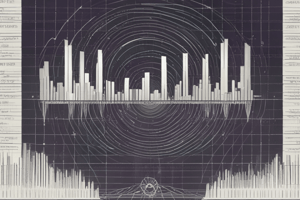Podcast
Questions and Answers
What is a box and whisker plot?
What is a box and whisker plot?
A graphical display showing the relative position of a distribution's three quartiles as a box on a number line, along with the minimum and maximum values.
What is categorical data?
What is categorical data?
Data that are described as a category or label.
What does Chebyshev's theorem state?
What does Chebyshev's theorem state?
Regardless of whether a distribution is bell-shaped, at least 94% of data values will fall within +/- three standard deviations of the mean, and at least 75% of data values will fall within +/- two standard deviations of the mean.
What is the coefficient of variation?
What is the coefficient of variation?
What is the empirical rule?
What is the empirical rule?
What does the five number summary consist of?
What does the five number summary consist of?
What is an index point?
What is an index point?
What is the interquartile range (IQR)?
What is the interquartile range (IQR)?
What is a left-skewed distribution?
What is a left-skewed distribution?
What is the mean?
What is the mean?
What are measures of central tendency?
What are measures of central tendency?
What are measures of relative position?
What are measures of relative position?
What are measures of variability?
What are measures of variability?
What is the median?
What is the median?
What is the midpoint?
What is the midpoint?
What is the mode?
What is the mode?
What are outliers?
What are outliers?
What are percentiles?
What are percentiles?
What is percentile rank?
What is percentile rank?
What is the Pth percentile?
What is the Pth percentile?
What are quartiles?
What are quartiles?
What is range?
What is range?
What are right-skewed distributions?
What are right-skewed distributions?
What is the sample correlation coefficient (rxy)?
What is the sample correlation coefficient (rxy)?
What is standard deviation?
What is standard deviation?
What is variance?
What is variance?
What is a weighted mean?
What is a weighted mean?
What is a z-score?
What is a z-score?
Flashcards are hidden until you start studying
Study Notes
Box and Whisker Plot
- Displays the relative position of a distribution's quartiles and its minimum and maximum values on a number line.
Categorical Data
- Comprises data described in categories or labels rather than numerical values.
Chebyshev's Theorem
- States that at least 94% of data values lie within +/- three standard deviations of the mean, and at least 75% fall within +/- two standard deviations, applicable to any distribution.
Coefficient of Variation
- Represents the standard deviation as a percentage of the mean, useful for comparing variance between different data sets.
Empirical Rule
- Pertains to bell-shaped distributions, indicating that approximately 68%, 95%, and 99.7% of values fall within one, two, and three standard deviations from the mean, respectively.
Five Number Summary
- Consists of five values: minimum, first quartile, median (second quartile), third quartile, and maximum.
Index Point
- Marks the median's position in the data set by identifying the middle value among the observations.
Interquartile Range (IQR)
- Calculated as the difference between the first and third quartiles, it represents the range of the middle 50% of the data.
Left-Skewed Distribution
- Characterized by a median that is higher than the mean, indicating a tail on the left side of the distribution.
Mean
- A central tendency measure calculated by dividing the sum of all values in a data set by the number of observations.
Measures of Central Tendency
- Values used to represent the center of a data set, including mean, median, and mode.
Measures of Relative Position
- Evaluate how a particular value compares in relation to the other values within the data set.
Measures of Variability
- Assesses the spread or dispersion of data points within a data set, including range and standard deviation.
Median
- The middle value in a data set, where half of the observations are above and half are below.
Midpoint
- The average of the endpoints within each class in a data set, used for classifying data.
Mode
- Represents the most frequently occurring value within a data set.
Outliers
- Data points that significantly deviate from the rest of the data, appearing much higher or lower than the majority.
Percentiles
- Indicate the approximate percentage of values in a data set that fall below a specific threshold value.
Percentile Rank
- Identifies the percentile corresponding to a particular value, indicating its position relative to the entire set.
Pth Percentile
- Defines the percentage of data points below a given value p (where p ranges from 1 to 100).
Quartiles
- Specifically refer to the first (25th), second (50th, median), and third (75th) quartiles, dividing the data into four equal parts.
Range
- A measure of variability derived from subtracting the lowest data point from the highest.
Right-Skewed Distribution
- A distribution shape where the mean exceeds the median, indicating a longer tail on the right.
Sample Correlation Coefficient (rxy)
- Measures the strength and direction of a linear relationship between two variables, helping to assess correlation.
Standard Deviation
- The square root of the variance, quantifying the amount of variation or dispersion in a set of values.
Variance
- A statistical measure detailing the spread of data points around the mean, reflecting how far individual values deviate from it.
Weighted Mean
- A mean calculation that incorporates different weights for various values, allowing for more nuanced analysis.
Z-Score
- Indicates how many standard deviations a specific value is from the mean, facilitating comparison across different distributions.
Studying That Suits You
Use AI to generate personalized quizzes and flashcards to suit your learning preferences.



